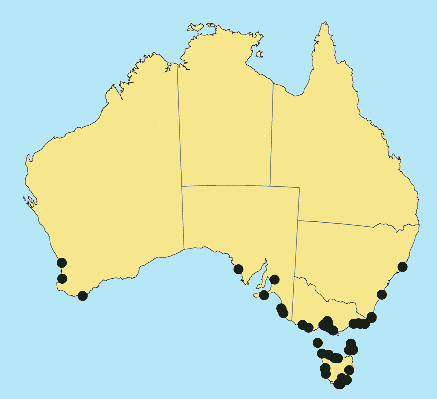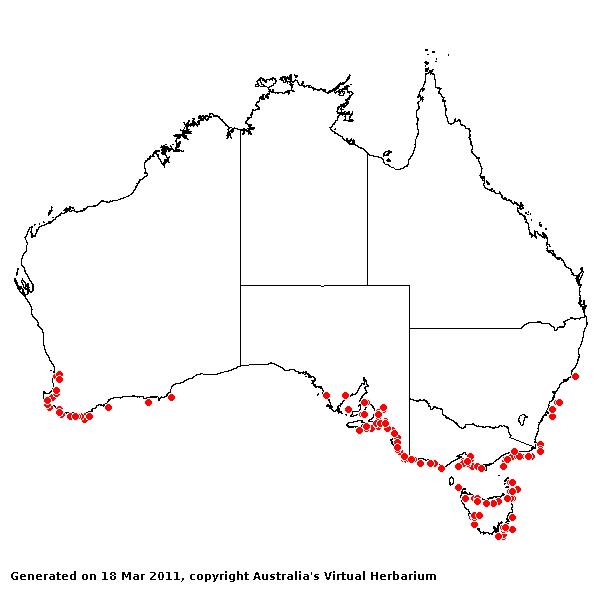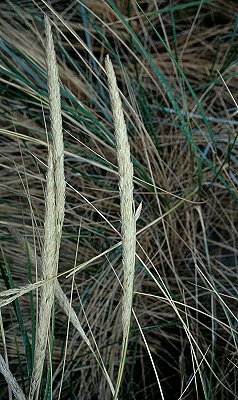Ammophila arenaria* (L.)Link. Hort. Berol. 1: 105 (1827). Classification. (GPWG 2001) : Subfamily Pooideae. Tribe Poeae.
Common name:
Marram Grass.
Basionym and/or
Replacement Name: Arundo arenaria
L. Species Plantarum 1: 82. 1753.
Type of Basionym or
Protologue Information: LT: (LINN-97.17). LT designated by Cope in Cafferty
et al., Taxon 49(2): 247 (2000).
Key references
(books and floras): [1952] C.A.Gardner, Flora of Western Australia 1
Gramineae (159), [2002] D.Sharp & B.K.Simon, AusGrass, Grasses of
Australia, [2002] J.Wheeler, N.Marchant & M.Lewington, Flora of the
South West (397), [2006] J.Jessop, G.R.M.Dashorst, F.M.James, Grasses of
South Australia (193), [2008] S.W.L.Jacobs, R.D.B.Walley &
D.J.B.Wheeler, Grasses of New South Wales (117), [2009] A.Wilson (ed.). Flora
of Australia, Vol 44A. Poaceae 2 (238 as spp. arenaria),
[1989] T.D.Stanley & E.Ross. Flora of South East Queensland, Gramineae 3 (117).
Illustrations:
[1952] C.A.Gardner, Flora of Western Australia 1 Gramineae (157,
Pl. 47), [2006] J.Jessop, G.R.M.Dashorst, F.M.James, Grasses of South
Australia (194, Fig. 143), [2008]
S.W.L.Jacobs, R.D.B.Whalley & D.J.B.Wheeler, Grasses of New South Wales,
4th edn (117), [2009]. A.Wilson (ed.), Flora of Australia 44A: Poaceae
2 (236, Fig.33).
Derivation: L.
arena, sandy place; -aria, pertaining to. Of sandy habitats.
Habit.
Perennial. Rhizomes present, elongated. Culms erect or geniculately ascending,
50–120 cm tall, 4 -noded. Ligule an eciliate membrane, 10–30 mm long, acuminate.
Leaf-blades involute or convolute, 20–60 cm long, 2–6 mm wide. Leaf-blade
surface indumented.
Inflorescence.
Inflorescence solid, a panicle. Panicle linear or oblong, 7–22.5 cm long, 1–2.5
cm wide.
Spikelets.
Spikelets pedicelled. Fertile spikelets 1 or more flowered, with 1 fertile
floret, comprising 1 fertile floret(s), with a barren rachilla extension,
lanceolate, laterally compressed, 10–16 mm long.
Glumes. Glumes
similar, thinner than fertile lemma. Lower glume lanceolate, chartaceous,
keeled, 1-keeled, 1 -nerved. Upper glume lanceolate, 10–16 mm long,
chartaceous, keeled, 1-keeled, 2–3 -nerved. Upper glume surface asperulous.
Florets.
Fertile lemma 8–12 mm long, keeled, 5–7 -nerved. Lemma apex entire or dentate,
mucronate or awned. Median (principal) awn subapical, 0.25–0.5 mm long overall.
Palea 2–4 -nerved. Anthers 3.
Continental
Distribution: Europe, Africa, Temperate Asia, Australasia, North America,
South America, and Antarctica.
Australian
Distribution: Western Australia, South Australia, New South Wales,
Victoria, Tasmania, Norfolk I.
Western Australia:
Drummond, Warren. South Australia: Eyre Peninsula, Northern Lofty, Yorke
Peninsula, Southern Lofty, Kangaroo Island, South-eastern. New South Wales:
North Coast, Central Coast. Victoria: East Gippsland, Gippsland Plain,
Otway Plain, Otway Range, Wilsons Promontory, Wannon. Tasmania: No
region given.
Notes. Coastal in all
states except Qld & N.T. Native to the coasts of western Europe. Initially
planted in many areas to stabilise coastal sand dunes, now naturalised. Flowers
Sept.-Feb.





